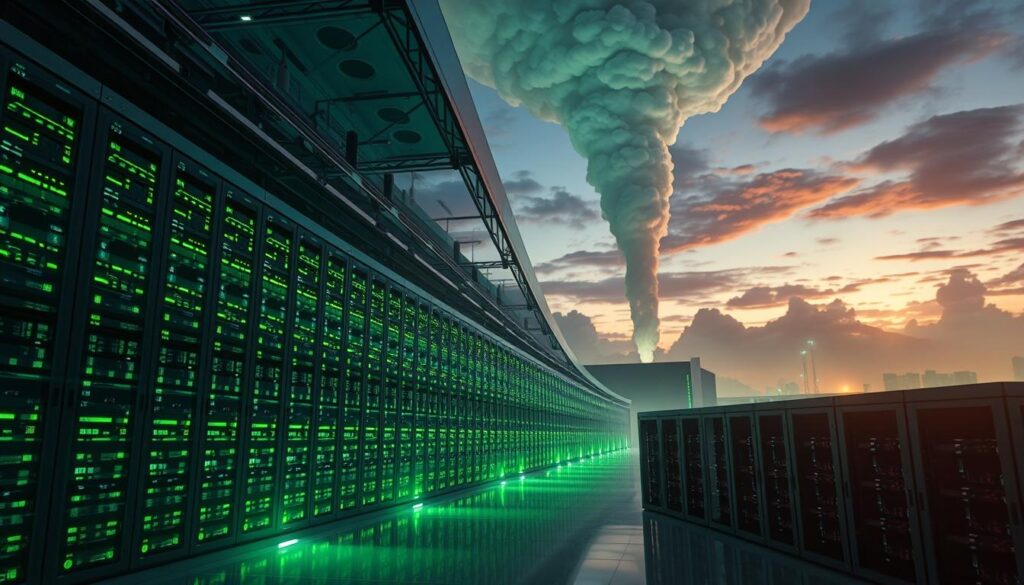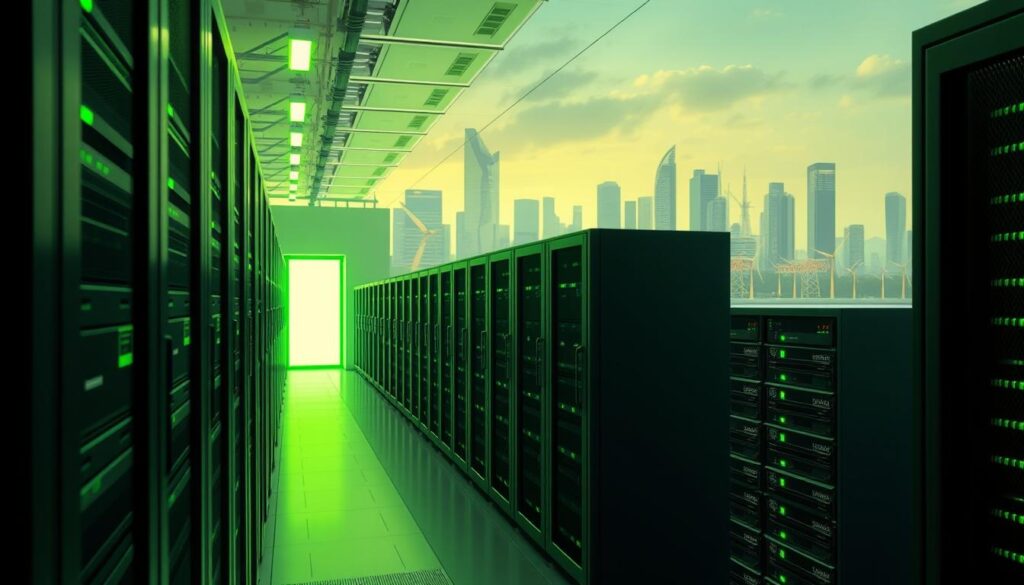In Culpeper County, Virginia, cows outnumber humans by a ratio of one to three. The state has approved seven large data-centre projects. These will use as much power as tens of thousands of homes, showing AI’s growing energy use.
As AI use grows, so does its environmental impact. Data centres in Virginia and worldwide use a lot of electricity. This is a big concern for our planet’s future.
AI’s rapid growth means more energy use. Data centres need a lot of power, leading to more carbon emissions. This puts a strain on our electric grid, making AI’s future sustainability uncertain.
AI’s benefits are exciting, but we must also consider its environmental cost. As AI becomes more common, we need to find ways to use energy more efficiently. Solving AI’s energy challenges is key to a sustainable future.
Key Takeaways
- Data centres housing AI infrastructure consume vast amounts of electricity, leading to higher carbon emissions and pressure on the electric grid.
- The rapid growth of AI technology has led to a significant increase in energy consumption, with some regions seeing data centres account for over 20% of their electricity use.
- Deploying and fine-tuning AI models requires substantial energy long after their initial development, further contributing to the environmental impact.
- Balancing the potential benefits of AI with its environmental footprint is crucial for sustainable development.
- Addressing the challenges posed by AI’s growing energy consumption is essential for ensuring a sustainable future for this transformative technology.
The Rise of AI and Its Environmental Footprint

Artificial intelligence (AI) has changed many industries, making things more efficient and automated. But, its fast growth has also shown its big environmental impact. This includes its carbon footprint and how much energy it uses.
AI’s impact isn’t just about the electricity it uses. It also affects water usage for cooling and the need for powerful computers. Data centres and networks use 1% to 1.5% of global electricity and 1% of greenhouse gas emissions, says the Electric Power Research Institute.
Rapid Growth of AI Technology and Applications
The AI market is expected to hit $71 billion by 2024, as Forbes reports. This growth has led to more advanced AI models, like ChatGPT. Training ChatGPT uses as much electricity as 120 American homes use in a year, notes Probst (2023).
Direct and Indirect Environmental Impacts of AI
AI’s impact isn’t just about carbon. It also affects the environment in other ways, like:
- Water usage for cooling data centres, which can strain local water supplies
- Demand for high-performance computing hardware, causing more emissions in manufacturing and transport
- Energy use when AI models are in use, making up 60% of their energy footprint (Electric Power Research Institute)
To tackle these issues, experts are creating energy-efficient AI systems and algorithms. The National Science Foundation (NSF) aims to cut computing’s carbon footprint by 45% in ten years. They’re getting a $12 million grant from the U.S. government to help.
As AI grows, we must fully understand its environmental effects. By finding sustainable ways to use AI, we can benefit from it without harming the planet.
AI’s Energy Consumption and Carbon Emissions

Artificial intelligence (AI) has grown fast, bringing big benefits but also worries about its effect on the planet. As AI gets more complex and common, its use of energy and carbon emissions are being closely watched. Data centres, where AI lives, use a lot of electricity, with North American ones using more and more.
Data centres worldwide use as much electricity as Italy does in a year. Goldman Sachs says data centres will use 8% of U.S. power by 2030, up from 3% in 2022. This big increase is because more people want AI and more data centres are being built for it.
Data Centres and Their Electricity Demands
Data centres need a lot of electricity. In Northern Virginia, they will need enough to power 6 million homes by 2030. Google’s data centres used 24 TWh of electricity in 2023, up from 18.3 TWh in 2021. As AI gets smarter, it needs more energy to train and use.
Training and Deploying AI Models
Training AI models like GPT-3 uses over 1,000 megawatt hours of electricity, making hundreds of tons of carbon dioxide. The BLOOM AI model’s training emits around 50 tonnes of greenhouse gases, more than an average French person’s yearly emissions. These numbers show how much AI training affects the environment.
Inference and Its Growing Energy Requirements
When AI models are used, their energy needs grow. A single ChatGPT query uses five times more electricity than a web search. If all Google searches were ChatGPT, 10 TWh of electricity would be used every year. This shows the big energy and carbon emissions problem with AI use.
To solve these issues, we need to make AI more energy-efficient and use green technology. We should make AI algorithms better, use renewable energy, and cool data centres in a sustainable way. As AI gets better, we must focus on using less energy and cutting its carbon footprint.
Water Usage in AI Infrastructure

The demand for AI technology is growing fast. This has made people worry about the environmental impact of data centres. These centres use a lot of electricity and water for cooling. With only 0.5% of Earth’s water available, the pressure on local water supplies is high.
There are about 11,000 data centres worldwide now. This number shows how much AI technology is needed. Google’s data centres use around 550,000 gallons of water every day. Even smaller ones can use up to 18,000 gallons daily.
A large data centre in the US uses as much water as 4,200 people. This is based on the average water use of 132 gallons per day per person.
Cooling Systems in Data Centres
Data centres use water-based cooling systems to keep their servers cool. These systems use between 0.26 and 2.4 gallons of water per kWh of server energy. As AI gets more complex, more water will be needed for cooling.
For example, generative AI is much more demanding than services like Google Search or email. It can be 100 to 1,000 times more intensive.
Competition with Local Water Supplies
Data centres use a lot of water, which can strain local supplies. In the US, over 5,300 data centres are operating. Around 20% of them use water from areas already facing water scarcity.
As AI technology advances, the competition for water will grow. This is a big concern for both data centres and local communities.
To reduce their water use, some tech companies are working on sustainable computing. Microsoft aims to be water positive by 2030. But, the fast growth of AI and data centres shows we need better solutions to use this technology sustainably.
Hardware and Material Impacts
The need for AI has grown, leading to more demand for computing hardware like GPUs. In Q3 of 2023, Nvidia sold over 500,000 GPU chips, making over $10 billion. Their stock price soared, reaching $877.35 per share in April 2024, making their market value over $2 trillion. But making these chips requires lots of raw materials, including critical minerals and rare earth elements, often mined harmfully.
Creating GPUs uses a lot of resources and energy, adding to emissions. Training AI models like GPT-4, with 1.76 trillion parameters, uses a lot of electricity. It’s enough to power almost 5,000 homes for a year. This is 40 times more than training GPT-3. The carbon emissions from training GPT-4 could be over 20,000 metric tons.
Data centres, needed for AI, create a lot of electronic waste. This waste is harmful to the environment and health. Only 20% of e-waste, like phones, is recycled. The mining for AI hardware materials often harms people and the environment.
It’s crucial for governments to involve affected communities in decisions. They should also stop planned obsolescence and support the right to repair. This can help make existing hardware last longer.
Challenges in Measuring AI’s Environmental Footprint
Artificial intelligence is growing fast and is used in many areas. But, it’s hard to measure its impact on the environment. This is because there’s no common way to report and measure AI’s effects.
Many companies making AI products don’t share how their work affects the environment. This makes it tough for experts and lawmakers to understand AI’s full impact. Without clear information, it’s hard to find ways to make AI more eco-friendly.
Complexity in Energy Attribution
It’s tricky to figure out how much energy AI uses in data centres. These centres handle lots of tasks, making it hard to pinpoint AI’s energy use. Here are some interesting facts:
- Data centres worldwide used 460 terawatts of electricity in 2022, making them the 11th biggest energy users.
- By 2026, data centres might use over 1,050 terawatts, possibly becoming the fifth biggest energy users.
- In Ireland, data centres could use almost 35% of the country’s energy by 2026 because of AI.
Without a clear way to track energy use, it’s hard to know the real environmental costs of AI. This makes it hard to make smart choices about AI’s growth.
“The rapid expansion of AI has outpaced our ability to fully understand and quantify its environmental impact. We need urgent action to establish standardised reporting and measurement practices to ensure the responsible development of AI.”
As AI’s demand keeps rising, it’s key for everyone to work together. We need clear rules for measuring and reporting AI’s environmental impact. Only then can we tackle AI’s energy use and aim for a greener future.
Potential Benefits of AI for Sustainability
Artificial intelligence (AI) is growing fast, but it also has a big role in making things more sustainable. It can help us use energy better, improve climate models, and find new ways to fight climate change.
AI can really help cut down energy use. The U.S. Department of Energy says AI could save up to 29% of energy in some places. This is very important, as data centres already use a lot of power and could use even more with AI.
Optimising Energy Efficiency in Various Sectors
AI can look at lots of data to find ways to use less energy. In farming, AI can make farms 20% to 40% more efficient. It helps farmers use resources better by looking at soil, weather, and crop health.
In factories, AI can cut energy use, waste, and carbon emissions by 30% to 50%. It does this by making production better, predicting when things need fixing, and reducing downtime. This makes factories more sustainable.
Enhancing Climate Modelling and Prediction
AI is also great for improving climate models and predictions. It can handle lots of climate data and run complex simulations. This helps scientists understand climate change better and make more accurate predictions.
AI can also make renewable energy systems work better. It looks at weather, energy demand, and grid performance. This makes solar, wind, and other clean energy sources more efficient and reliable. It helps us use less fossil fuel and makes energy more sustainable.
To make the most of AI for sustainability, we need to balance its environmental costs with its benefits. We must carefully look at AI’s energy use, water, and material impacts. We also need to make sure AI is developed and used in a way that’s good for the planet.
Balancing the Benefits and Risks of AI Deployment
AI is changing our world in many ways. We must think about its good points and the bad for the environment. AI can help save energy and cut down on waste and pollution. But, making and using AI can also harm our planet.
The growth of AI has made us worry about its impact on the environment. Data centres, which power AI, use a lot of electricity. They now use about 1% of the world’s electricity. This could go up to 6.7% to 12% in the U.S. by 2028.
Training one big AI model can release 300 tons of CO2. Most of the cost of using AI comes from tasks that use a lot of energy. This is a big problem.
We need to make AI better for the planet. This means using less energy and making AI hardware in a green way. We should also use renewable energy. This will help reduce AI’s harm to the environment.
Choosing the right data centre location can also help. It can cut down emissions by at least 60%. Using efficient AI models can also save a lot of energy and reduce pollution.
We also need fair rules for AI. This will make sure everyone gets a fair share of AI’s benefits. It’s important to remember AI’s good and bad sides as we move forward.
Artificial Intelligence Green Effect Power Consumption
Artificial intelligence is changing our world fast. It’s important to think about its effect on the environment, like how much power it uses. AI’s growth has made data centres and computers use more energy.
Google’s carbon emissions have gone up by nearly 50% in five years. This is mainly because of its AI data centres’ power use. Microsoft’s emissions have also risen by almost 30% since 2020. These numbers show we need to really look at AI’s environmental impact.
To understand AI’s power use, we must look at a few things:
- How much electricity AI models need to train and deploy
- The water used to cool data centres
- The energy needed to make AI hardware and the waste it creates
Using generative AI in Google searches could need 400,000 to 500,000 NVIDIA A100 servers. This would use 23–29 terawatt hours of energy every year. Each AI server request uses 23–30 times more energy than a normal Google search.
The Need for Responsible AI Development
We must make AI development more responsible to reduce its harm to the environment. This can be done in several ways:
- Make AI algorithms more efficient to use less power
- Use green energy to power data centres
- Design AI with the environment in mind
By focusing on responsible AI development, we can lessen its environmental impact. This way, we can still enjoy the benefits of AI technology.
Regulatory and Policy Initiatives
As AI’s environmental impact grows, governments are taking action. The European Union and the United States are leading with new rules. These aim to reduce AI’s carbon footprint.
The EU now requires companies to share AI’s environmental effects. This move towards clear reporting is a big step. The US is also looking into how to manage AI’s environmental impact.
Industry leaders and green groups want standardised ways to measure AI’s impact. They want a common way to track and reduce AI’s environmental harm. This would help manage and lessen AI’s effects on the planet.
Emerging Legislation in the EU and US
The EU’s new rules are a big step towards controlling AI’s environmental harm. Companies will have to assess AI’s environmental impact and share this with authorities. This push for transparency is expected to lead to more eco-friendly AI practices.
In the US, lawmakers are also working on AI’s carbon footprint. They’re looking at ways to encourage energy-efficient AI and set guidelines for its use. These steps aim to keep AI’s benefits while reducing its environmental costs.
Calls for Standardised Reporting and Disclosure
There’s a growing push for standardised reporting and disclosure in AI. This would help track and manage AI’s environmental impact. It would also help everyone work together to make AI more sustainable.
Standardised reporting would make it easier for companies, researchers, and policymakers to collaborate. By sharing knowledge and resources, the AI community can reduce its environmental impact. This way, AI can still offer great benefits while protecting our planet.
With more focus on AI’s environmental impact, it’s clear we’re all moving in the right direction. By working together, we can make AI responsible and sustainable. This will ensure the technology benefits us without harming our planet for future generations.
The Role of the Tech Industry
The tech industry must act fast to tackle the environmental issues linked to AI. AI, data centres, and cryptocurrency use about 2% of global electricity now. This could double by 2026. It’s vital for tech companies to focus on making their AI work sustainable.
Improving algorithm efficiency is a big step for the tech industry. By making AI workloads use less energy, companies can cut down on carbon emissions. For instance, making 1,000 images with Stable Diffusion XL is as bad for the environment as driving four miles in a gas car. By working on algorithm efficiency, tech companies can lessen the harm their AI does to the planet.
Greening data centres is another key area for the tech industry. Data centres are growing fast, using as much electricity as Italy. Tech companies need to use renewable energy and efficient cooling systems. Gen AI is changing the energy and materials, and tech companies must lead in making their data centres sustainable.
Offsetting Emissions and Collaborative Efforts
Offsetting carbon emissions is also important for tech companies. Even companies like Google, aiming for net-zero by 2030, have seen their emissions rise by nearly 50% in five years. This is mainly because of AI data centre electricity use. By supporting clean energy and carbon offset projects, tech companies can reduce their AI’s environmental impact.
Fixing AI’s environmental problems will need teamwork from tech, academia, and governments. By working together, we can make AI sustainable. This way, AI’s benefits can be enjoyed without harming our planet.
Conclusion
AI is changing our world fast, but we must think about its impact on the environment. The growth of AI has led to more energy use and carbon emissions. Data centres, which power AI, could use up to 9% of global energy by 2030.
This increase in energy demand adds to carbon emissions and strains local water supplies. For example, Microsoft’s data centres in Iowa used 11.5 million gallons of water for GPT-4. This was 6% of the area’s water supply.
To reduce AI’s environmental harm, we need sustainable AI strategies and tech industry responsibility. We should work on making algorithms more efficient and greening data centres. Also, offsetting emissions is key.
Regulations, like those in the EU and US, help by requiring AI energy and emissions reports. By working together, we can use AI’s benefits while protecting our planet for the future.
The future of computing depends on sustainable AI solutions. AI can make energy use more efficient and help with climate issues. But, we must consider its environmental effects.
By doing thorough assessments and promoting responsible AI, we can make sure AI’s benefits are worth the risks. As we progress, prioritising sustainability in AI development is essential, this ensures AI supports a greener, more sustainable future.
Want to hire me as a Consultant? Head to Channel as a Service and book a meeting.

